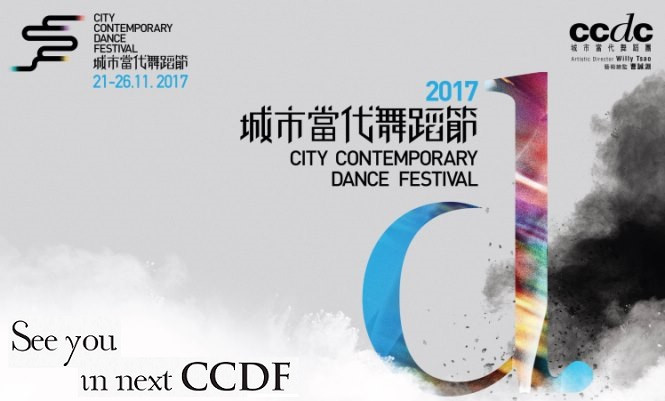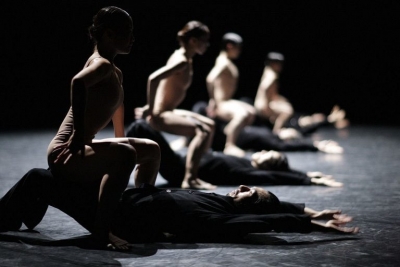Words are important, I often say. It’s important to handle words with care and to use them wisely. It might be more important than ever in this digital era when words fly fast across the Internet, and often out of context.
With this said, a topic such as ‘Re-imagine dance in Asia’ calls for some definition. What is Asian dance? What is Asian? Who represents Asia? And what is dance? Which dancer, performing artist or choreographer represents dance? And how do we imagine, and re-imagine, all this?
City Contemporary Dance Festival Hong Kong 2017
At the Chatbox Symposium of the City Contemporary Dance Festival in Hong Kong on November 25, 2017, my fellow dance critic Pawit Mahasarinand said that defining Asian dance – and agreeing to a definition – would be as tough as everyone being happy with one definition of Asian food. The comparison led me to conclude that the fairest definition of both ‘Asian food’ and ‘Asian dance’ would be no fixed definition at all.
From the outset, we must consider perspective. Seen from afar, ‘South East Asia’ or ‘The Far East’ describes not those regions but the Occidental view of the world – also testimony to the geographical narcissism of the West. While we may ridicule such terms, they nonetheless exist and impact what we see and do – and how we dance.
We all have preconceptions. While travelling we do not as much explore as compare what we see with what we ‘know’. That’s reductive while the world is not. Yet we cannot escape stereotypes, notions and ideas. We can, however, learn from them.
Our ideas can’t be ignored. Ideas of who we are and who ‘they’ are commingle, more so today in our hyperconnected, globalised world. ‘Asian dance’? We’re too many and too different to ever find one definition, unless it is really broad: a mix of histories, aesthetics and even politics. But for such a huge region any single definition, no matter how broad and fluid, would become almost useless.
So any example of this commingling? Chinese dance education derives from classical, Western ballet, for instance. Pondering that, I am, to be honest, tempted to drop the terms ‘Asian’ and ‘European’ when it comes to dance.
Yet, stereotypes are often used in art and are quite frequent in performance art, as stereotypes effectively communicate with the audience. Stereotypes are not always problematic because they do not have to be exoticist, racist or sexist. But sometimes they are just that – and that too can communicate meaning. In an artistic context one can use a stereotype in order to question stereotypes.
Performance art always communicates with an audience. Dance is, often, wordless communication that relies on movement and images. Choreography is Greek for ‘write dance’ (choreia = dance, grafein = write) and the body writes the dance. We all have bodies. Thus dance crosses borders that spoken language cannot.
And yet dance, as we know it today, sometimes does involve spoken, or even written, words; sometimes dance doesn’t even include any dancing, as we know it in the traditional definition of the body moving to music. So one has to expand in order to define: let’s say ‘some kind of body doing something in some kind of space before some kind of audience, often with some kind of sound or music.’
With all the lead-up to so many potential categories, we must ask: how to categorise dance? We can measure some aspects of it – for example, by placing the performance on a sliding scale of how much acting it involves. What’s a ten out of ten for ‘acting’? I’d say a character playing something s/he’s not (e.g. a white, tall male acting the part of a (fictional) non-white, short female). Hell, they might not even be playing human beings. What’s one out of ten then? The performer is just him- or herself and the performance has no props that we’d associated with the theatre.
We often see no or little ‘acting’ or theatrical elements in what we know as contemporary, or ‘modern’ dance. But sometimes we do. There might be no narrative. But sometimes there is, or we find one. Almost everyone searches for a narrative, however. We are born and bred to like stories – symbols, analogies, metaphors, wisdom, faith and fate, and a conclusion. We use our preconceptions to find meaning. For example, when a man and a woman dance a duet we tend to look for romance; when an old man and a young man antagonise each other we see the Oedipal complex.
Let me share my preconceptions. Suppose I am a Swedish dance critic on her first visit to Hong Kong to see dance. I cannot escape my perspectives, my ‘understandings’ and my biases. My exposure to ‘Asian dance’ has also been limited. I have not travelled much in this region. And while Asian dancers do visit Sweden, I can’t catch every performance. But of course, having been a dance critic for many years, I have seen some performances and they have shaped my ideas and my expectations. Also, many dance companies are truly international, with a mix of different nationalities among their dancers, like for example the Swedish Cullberg Ballet.
Just as I can’t catch every performance, I can’t catch every dance form. My experience with the City Contemporary Dance Festival has been limited to contemporary dance from a few places in Asia: Hong Kong, Beijing, Shanghai, the Pearl River Delta, Taiwan, Japan and South Korea.
As an outsider and a guest at the festival, I rely on the curators to choose for me the best and the most thought-provoking performances, made possible, of course, by timing, logistics and costs. Thus I understand that what I saw were a few examples of dance from Asia, and will not let these performances make me think I have found the one true definition of Asian Dance. But I will for sure have some food for thought later when I re-imagine it from my own perspectives.
One perspective that I brought with me to Hong Kong originates from a recent (and quite lively debate in Sweden – conceptual dance versus ‘dance dance’. The discussions began when a broadsheet critic slammed the growing number of conceptual dance works (or ‘performance dance’) presented in Sweden – productions that mix performance art, theatre and other artistic disciplines with contemporary dance; or pure performance art staged at a dance venue or dance festival. This critic wanted more ‘dance dance’ as if, I’d retort, one must exclude the other. Conceptual dance does not threaten or have to crowd out ‘dance dance’, a term many of us have started to use sarcastically. In my opinion, the interdisciplinary works are often interesting, as different artistic elements can help choreography to develop.
As a side note, ‘dance dance’ is quite a useful term. I do not critique dance for other critics, but for dance lovers and enthusiasts who want to watch and read about dance but cannot, or even want to understand an in-depth review based on theory.
‘Dance dance’ – that’s what I saw the most at the Festival. There were few works I’d call dance theatre or dance performance which, more importantly, often have a clear narrative and/or a political message. That made me wonder whether interdisciplinary dance works and political dance is a Western thing. Is it not desired or appreciated in Hong Kong, or are there fears for censorship or backlash?
NINA
NINA – materialize sacrifice by Jo Kanamori of Japan proved to be an exception. It started with five women in skin-tight beige costumes lying so still and tense on the stage that I at first actually wondered if they were mannequins. Five male dancers in black suits, a capitalist code for power and masculinity, dominated the women, who throughout the performance danced with robotic movements. Display of not only gender power structures but also scenes of sexual violence in an elegant, stylised aesthetic form helped the dance, at least for me, raise thoughts about equality and power. Was that the choreographer’s intention? Did I see this dance, originally created 13 years ago, through recently acquired #MeToo goggles just when that hashtag had begun its digital dance across the globe? The only true answer? I do not know.
Kanamori’s piece left me with this: interpretations can be reinterpreted, and the dated can be updated. The if and how depends not just on the when, but the where. For example, a Chatbox audience member guessed that this dance piece would be condemned as too sexist in the Nordics, not least now as #MeToo is reverberating with force – forcing many high-profile men out of their jobs in Sweden. “Au contraire” (On the contrary), I’d say. I think #MeToo made this work even more relevant and would ‘work’ also in Sweden. I think the Swedish audience would appreciate both the content and the aesthetics, with the sharp, strong, physical dancers and their icy, mechanical and rhythmic expressions.
That the women looked like cyborgs makes this work even more poignant as the robot revolution is nearing. And as Japan leads the way in artificial intelligence, isn’t it more poignant than ever? The work flipped a switch in my memory of reading an article about Japanese men marrying virtual wives. That association is, however, based on my limited knowledge of Japan and on what the algorithms of the Internet have chosen to display to me. That association only goes to show that knowledge and limited knowledge informs the way we interpret dance. And a note to add: I found something ‘Asian’ in this piece! I saw what I see as something Japanese, from my perspective as a Swedish, female, politically aware, middle-aged, highly educated, well-travelled, well-paid, middle-class, dance critic.
And finally, a note on values. How you see this work depends on how you view gender and gender roles, on whether you value gender equality. A person that I’d classify as a male sexist brute may find beauty, order, logic and solace in these scenes. He might also see the male fears of losing power and control over something he used to rule – women and machines, whereas I see abuse, violence, dominance and servitude,. And I rejoice when the women strike back, grabbing the men, stripping them; when the women go from object to subject, from passive to active. This made me see this piece as not sexist, even though sexist stereotypes were shown on stage, but a comment on sexism.
And as for robots, let’s not forget who are creating and programming the artificial intelligence. Robots are not neutral, not automatically free from stereotypes, racism or sexism. They are only as unbiased as the human beings who programmed them. Which makes the metaphor on stage even more interesting. It’s the human beings who have the power to change the world and to decide to make it more equal.
So this Swedish dance critic saw a worldwide topic being discussed (#MeToo is basically a #FuckYou) through the use of gender stereotypes, a perception strengthened when I, the Swedish female feminist dance critic, connected the choreographer’s nationality to my stereotypes of Japan.
作者簡介:駐瑞典國家公共廣播電台的劇場和舞蹈評論人
照片拍攝:篠山紀信






